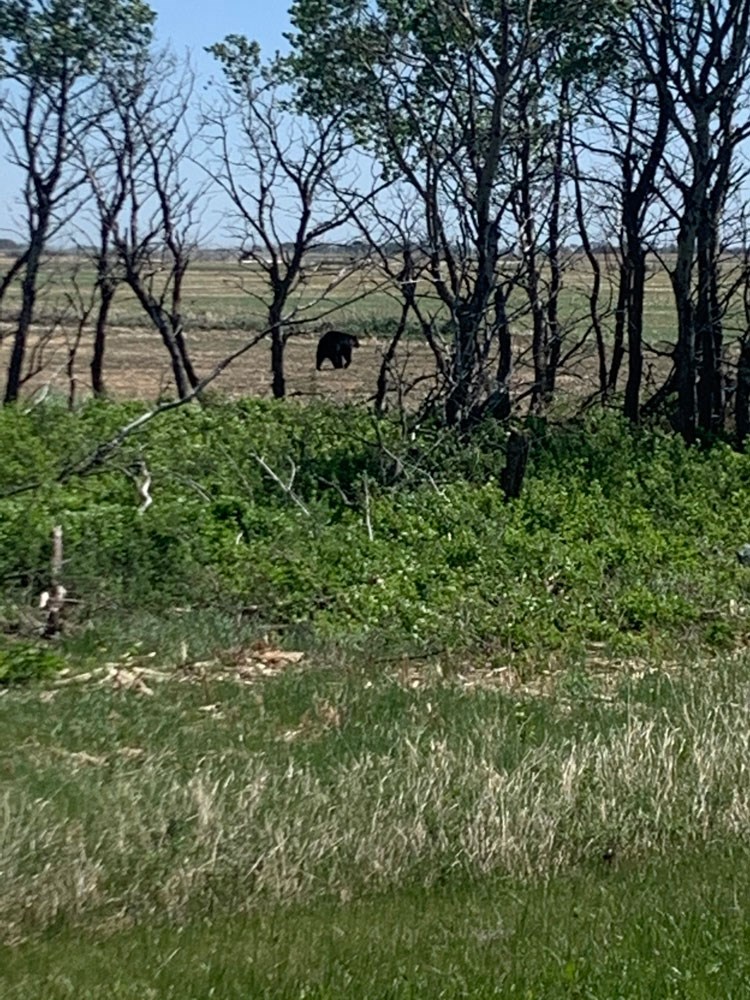Tyler Miiller observed something he won’t soon forget while at work on June 1.
Miiller, who lives in Estevan, spotted a black bear about 10 kilometres west of Highway 47, just north of the 705 grid road that runs from Halbrite to north of Benson.
He’s originally from the Lloydminster area, and there are quite a few bears in that area, but he was shocked when he saw one in southeast Saskatchewan.
“I wasn’t expecting to see a black bear this close to home anyways,” Miiller said.
Once he saw the bear, he stopped his truck, backed up and took some pictures.
“I watched him for a little bit,” Miiller said.
The animal was about 150 metres away, and Miiller has had closer encounters with the species, so he wasn’t frightened when he saw the animal. Despite the distance, he was able to make a positive identification of a bear right away. And he was next to the truck.
In fact, he believes the bear was more afraid of him than he was of the animal.
“When he saw me backing up, he started trying to run for cover,” said Miiller.
The bear started to head southeast and then moved northeast. There have been reports of bears in the Stoughton area and the Fillmore area recently, but Miiller said this bear seemed to be bigger than the one seen in Fillmore.
Lindsey Leko, a conservation officer based out of the Ministry of the Environment’s Weyburn office, asked that people call if they see a bear.
“If we get any kind of bear activity, we sure would like to know about it, regardless of whether it’s just a sighting, or whether it’s a problem animal. It’s important that the public calls us, and lets us know, so that if it does become a problem, well then we can come over and quickly deal with.”
As for the sighting last month in the Fillmore area, Leko said it was a brown bear.
In most instances, the Ministry of the Environment hears of bear sightings through social media. Somebody will see a bear and take a picture of it, possibly when it’s up a tree, and then share the photo on a social media platform.
But he wants people to remember conservation officers aren’t monitoring social media throughout the day.
Bear sightings in the southeast aren’t common, but they do happen from time to time, and they happen enough that a bear-hunting season happens in several zones in the southeast and east-central regions.
“The young, at about two years, get kicked out of the den by the mother, and then they have to try to find a new territory,” said Leko. “That’s probably what we’re looking at … is juvenile bears who have recently been kicked out of the den. They’re looking for a new place to live, they’re looking for food.”
Bear sightings are more common in northern Saskatchewan, and people up there have learned to co-exist with them, he said. Residents are smart about what they leave outside.
“Bears are attracted to food. They’re going to want something to eat.”
If someone is out walking and they notice a bear, and it hasn’t noticed them, Leko hopes the person will stop and start walking backwards. Don’t take your eyes off the bear, because in most cases, the bear will be more afraid of you than vice-versa.
If the bear is actively pursing you, then do your best to appear big and assertive.
“In the unlikely event that it attacks, with a black bear you’re going to want to make sure you fight back with everything you have. If you have a stick or … a rock, or you punch it, whatever it takes to scare it off, that’s what you’re going to have to do.
“A lot of times bears will make a false charge. They’ll run at you and then they’ll stop at the last second, in hopes of trying to scare you off.”
People are also allowed to protect themselves, their property and livestock from bears, but after situation is resolved, they need to call a conservation officer as soon as possible so the incident can be investigated.
And even they’re isn’t an attack, Leko reminds people to call conservation officers.
“If we don’t know that the bears are out there, then it’s hard to deal with them. I would much rather have good knowledge of where they’re at, and there’s a good chance that we could actually relocate it to a place that’s maybe a little more suitable rather than somebody’s farm.”



